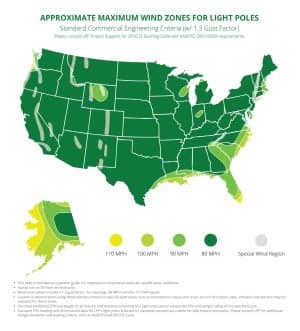A critical, though often overlooked, element of light poles is how well the system will hold up under powerful winds. 
LED Lighting Holds Strong Against the Storm

LED technology is an effective solution to high winds, for two reasons. Both reasons have to do with the way LEDs are engineered, and include:
- LEDs are inherently more durable than other forms of lighting. Incandescent, fluorescent and high discharge lamps have been around for decades. And though they are built better than ever before, they still use outdated technology to produce light. Specifically, they come with components that are susceptible to impact or movement, such as metal filaments or bulky ballasts. This means a sudden gust might be enough to knock these fixtures out.
- LEDs are not affected by wind the same way because they are built with sturdy components. An LED functions by shuffling around electrons in a semiconductor chip, a process that is extremely granular and one that can be managed on an integrated circuit. To put it in easy to understand terms, integrated circuits aren’t made with “wobbly” components, so they don’t whip around in the wind and sustain damage by striking something. For this reason, LEDs are much more resistant to impact and wind forces.
- Lighting systems that use LEDs are much lighter than other systems. Again, incandescent, fluorescent and high discharge lamps are using outdated technology and engineering. Weight is a major concern when executing a parking lot lighting project. High discharge lamps are the traditional choice for parking lot lighting poles, but they are made with heavy metal and glass components. High discharge lamps also need bulky ballasts and internal reflectors, both of which drive up the weight of the fixture. Heavy lights not only require additional engineering to accommodate on a pole, they are also more likely to fail in high winds. The additional bulk can turn the fixture into a liability when it begins swinging around due to gusting, placing enormous pressure on the fixture’s anchoring components.
- LEDs don’t need cumbersome ballasts or reflectors to produce clear, precise illumination, and integrated circuits are much lighter than the tungsten electrodes found in high discharge lamps. By cutting out most of the weight, designers can install LEDs without having to rely on extensive anchoring, which itself is also heavy. Put it all together, and LEDs offer a clear weight advantage, making them less likely to fail when the wind kicks up.
Don’t Dismiss the Power of Wind

For this reason, LEDs should be given a closer look in these cities. But improved wind ratings are just one benefit of LED systems. Excellent efficiency and longevity are also part of an LED lighting package, and will drive operational costs down further. For property owners that place a premium on system reliability, LEDs cannot be beaten.
LED technology is the most promising development in lighting in a long time, and it brings across-the-board benefits for both home and business owners. One of those benefits is improved wind resistance, which is of particular use to any property that requires a large scale lighting system.






